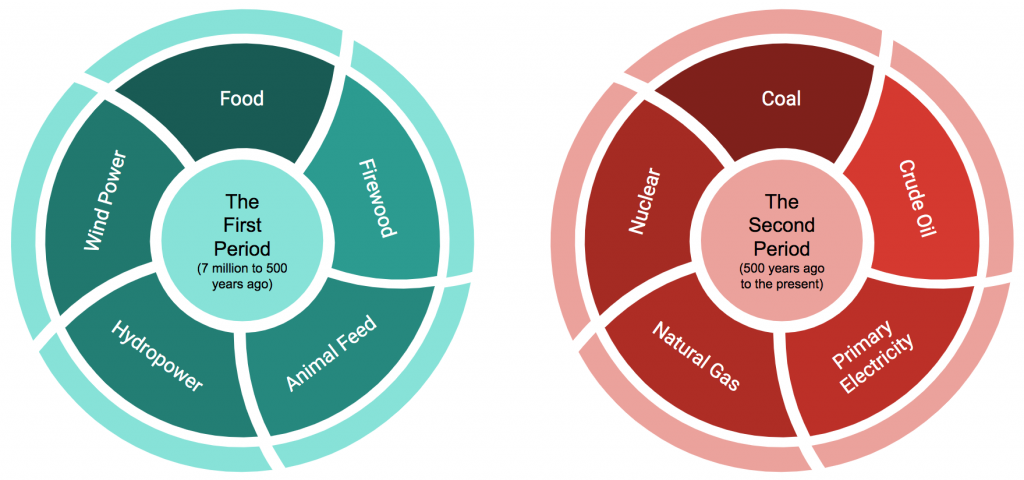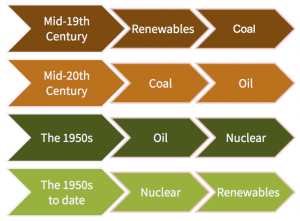Energy Transition Blog Series #1
Energy in human civilization
Paolo Malanima, an economic historian from Italy, classifies the history of the world energy into two periods based on the utilization of energy source. The first period ranges from 7 million to 500 years ago, marked with five prime energy sources, namely food, firewood, animal feed, hydropower, and wind power. For about 5 to 7 million years ago, food is known as the only energy source by a human with other two forms of energy (i.e., kinetic and thermal). They only relied on their body and animals to perform some works with limited usage of hydro and wind power. For this reason, he then called this period as the organic vegetable economy.
The second world energy period spans from the present to last 500 years ago. In this era, the prime energy sources for human and animals have been replacing by fossil fuel-based, along with the development of machine tools and mechanization. The fossil energy sources which have been utilized are from coal, crude oil, primary electricity, natural gas, and nuclear, respectively. So, for this second period, Paolo Malanima called the era as the organic economies.

From these two periods, the common principle to extract the energy remains the same: by burning the carbon. While the first period used direct timber and other traditional biomass as the carbon source, the modern period uses the “fossil” carbon from ancient plants and organisms which subject to intense heat and pressure over millions of years. The changes in the use of fuel between these periods encourage the emergence of the energy transition.
What is energy transition?
The energy transition can be interpreted simply as “changes in the system of energy production and consumption in a certain period of time.” Nowadays, the terms globally referred as the transformation process in the energy supply in which from fossil fuel-based energy system (i.e. coal, oil, and gas) towards a more efficient, low carbon, and sustainable energy system with renewables (e.g. solar, wind, bioenergy, hydro). The current transition is driven to achieve global climate mitigation goals in limiting global warming to 2oC – or even limiting to 1.5oC.
Energy transition phenomenon is actually already started a long time ago. It began in the mid 19th century by the utilization of coal as the main source of energy, followed by the introduction of oil in the 20th century, and nuclear in the 1950s. From the 1950s to date, the energy supply from renewables has been taking over the dominance of the non-renewables. It’s fairly to say that the global energy transition has undergone under four major waves (see Figure 2).

The first global energy transition arguably marked when Thomas Newcomen and James Watt invented the steam engine in the late-18th century. In this era, there have been changes in the number and pattern of energy use as well as the energy-carrying substitutes – which were originally dominated by biomass (firewood) to coal and oil later in the mid-20th century. Further, the geographical distribution of energy production, the commercialization of energy resources, and the impact of energy use on the environment began to be visible in this industrial revolution era.
The era of industrialization – along with the discovery of electricity and the increasing population of the world, pushed for greater demand for energy. Coal and oil have more energy density than biomass. Hence, these two sources of energy had been used massively in the era to supply the needs. As a consequence, biomass utilization was dramatically decreased and the new type of energy, i.e. electricity, was started to increase.
High utilization of coal and oil – plus economic development, not only increased fossil fuel usage but also encouraged the development of technology towards more efficient and more environmentally friendly. That’s why the introduction of nuclear energy to generate electricity in the 1950s marked as the third wave of the global energy transition. The world’s first nuclear powerplant started operations in Obninsk, in the Soviet Union, on June 27, 1954.
The fourth wave of the global energy transition marked by the reduction in the use of fossil fuels, especially in developed countries. With the threat of climate change and its impact, countries in the world then agreed to require the transition of the current energy system towards a cleaner system by using renewables. Solar and wind energy are among the most renewable sources which have a rapid deployment around the globe.
“Back to the future past”
Maybe not many people are aware that we finally return to the original wisdom of energy use in the past. If we referring back to the Paolo Malanima’s classification, our ancestors had been evidently used the renewable energy to empower their work in the first place. With technological advancement, we can back to use past wisdom in tapping the energy from renewable energy sources, in more effective ways.
Current renewable energy technologies, combined with the storage system, can substitute the dirty fossil power plants without having the reliability. The rise of micro-power and decentralized generation globally indicates that we no longer need the big, centralized power plant. Moreover, the digital revolution in the energy sector (e.g. digitalization, internet of things) also accelerate the energy transition towards a more efficient, low carbon, and sustainable energy system with renewables.
So let’s turn, not burn!
Jannata Giwangkara,
Program Manager – Energy Transformation

